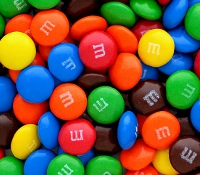
Since its post-war debut, atomic energy has been an attractive power source for our crowded planet. While never "too cheap to meter," some 20 percent of America's electricity now comes from nuclear plants that emit no greenhouse gases. Nuclear engineers design propulsion systems for subs and ships as well as civilian and research plants. This week's lesson will fuel your atom smashers' interest. No meltdowns here! For Navy-related student research opportunities, check out the Science and Engineering Apprenticeship Program (SEAP) and the Naval Research Enterprise Intern Program (NREIP). Download our Teacher Guide for more ideas! |
| Lesson: Atomic Candy
 In this activity developed by the Science House at North Carolina State University, students in grades 5 - 11 will use M&Ms to learn about radioactivity, the rate at which an isotope decays, and the concept of half-life. They will count and record the number of decayed "atoms" and graph the results. In this activity developed by the Science House at North Carolina State University, students in grades 5 - 11 will use M&Ms to learn about radioactivity, the rate at which an isotope decays, and the concept of half-life. They will count and record the number of decayed "atoms" and graph the results.
Read More |
|
Feature: Nuclear Energizes Teachers
 Despite the anxiety triggered by last spring's nuclear disaster in Japan, nuclear power is still a key part of this country's energy mix. Industry and universities are enlisting help from teachers in preparing the next generation of nuclear engineers and technicians. Despite the anxiety triggered by last spring's nuclear disaster in Japan, nuclear power is still a key part of this country's energy mix. Industry and universities are enlisting help from teachers in preparing the next generation of nuclear engineers and technicians.
Read More
|
| K-12 News: School Curbs Potty Breaks
 Truancy and absences can erode student learning. But bathroom breaks? Borrowing a page from that saucy staple of high school musical comedy, "Urinetown," Evergreen Park High School in Illinois has instituted a new policy limiting students to three bathroom passes per semester in an effort to curb excessive trips that take away from valuable class time. Truancy and absences can erode student learning. But bathroom breaks? Borrowing a page from that saucy staple of high school musical comedy, "Urinetown," Evergreen Park High School in Illinois has instituted a new policy limiting students to three bathroom passes per semester in an effort to curb excessive trips that take away from valuable class time.
Read More
|
| Special: ASEE Partners with NSTA
 The American Society for Engineering Education (ASEE) has put together a public/private partnership to develop ways of engaging elementary, middle, and high school students in engineering. Participants will learn about innovative, hands-on, project-based engineering at three events during National Science Teachers Association regional conferences. The American Society for Engineering Education (ASEE) has put together a public/private partnership to develop ways of engaging elementary, middle, and high school students in engineering. Participants will learn about innovative, hands-on, project-based engineering at three events during National Science Teachers Association regional conferences.
Read More
|
 What do the blockbuster "Avatar," high-performance sports gear, Angry Birds phone app, and pollution-eating bacteria have in common? What do the blockbuster "Avatar," high-performance sports gear, Angry Birds phone app, and pollution-eating bacteria have in common?
They are among a host of cool innovations developed by engineers and featured in the new fifth edition of the American Society for Engineering Education's Engineering, Go For It magazine. The kid-friendly magazine is part of ASEE's campaign to inspire more K-12 students, particularly young women and underrepresented minorities, to pursue engineering majors and careers. Now available in our store! |
|
|